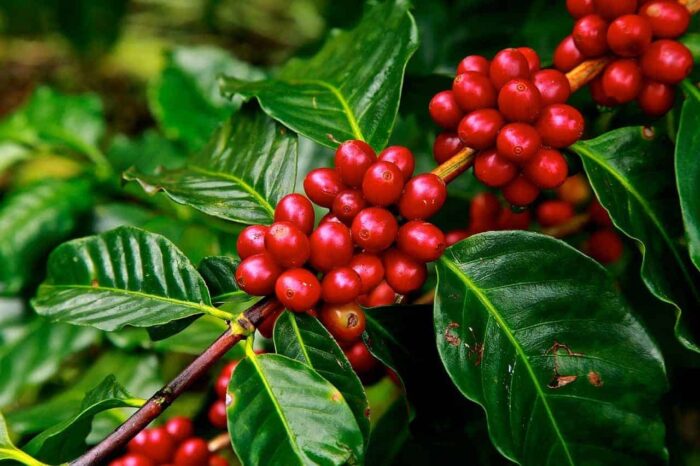That morning cup of coffee is a ritual for so many people across the globe. But have you ever wondered exactly how those coffee beans are grown and processed to end up in your mug? The journey from seed to bean is quite fascinating. In this post we talk about How Does Coffee Beans Grow.
Coffee plants produce a fruit called a coffee cherry, which contains the seeds we know as coffee beans. It takes about 5 years for a coffee plant to mature enough to grow cherries. Once ready, it will continue fruiting for 15-20 years. The labor-intensive process spans many months each year.
Planting & Early Growth
It all starts with planting either seeds or young seedlings into fertile soil under filtered sun. Coffee thrives best in tropical climates along the Equator, ideally with altitude, rich soil, moderate temperatures and plenty of rainfall. Too much sun exposure can damage leaves.
The planted coffee seed germinates in about 8 weeks. The young plant grows slender stems and leaves as it develops a strong root structure underground. This slow establishment period for new crops generally takes 3-4 years. Proper pruning, weed removal and fertilization has to be meticulously maintained during this time.
First Flowers & Cherries
Once the coffee plant matures after about 5 years, flowering begins. The plant produces small, fragrant white blossoms that last only a few days. Then tiny green coffee cherries emerge just 7-9 months after flowering. This first set of cherries is typically not harvestable though.
It takes up to 9 months more for the green cherries go to fully ripen. Cherries don’t all ripen at the same time, requiring selective harvesting. Under optimal conditions, one tree can produce up to 10 pounds of coffee cherries annually.
Inside each red-ripe cherry are two green coffee beans covered in the fruity flesh and protected by an outer skin called the pericarp. These layers shield the inner beans from damage and pests. The composition of the fruit helps enhance flavor development of the beans over the coming weeks.
Selective Hand Harvesting
Timing of harvest is crucial for flavor. Pick too soon and the bean won’t fully mature. Too late allows overripe flavors and fruit defects to set in. Multiple selective pickings are done as cherries reach peak ripeness.
In most regions, harvest occurs between September and December. Workers have to manually comb through the crops daily seeking perfectly ripe cherries. Their skilled hands pick only the optimal cherries, leaving others to continue ripening longer on the trees.
Wet Method vs. Dry Method
After harvest, the coffee beans have to be extracted from the cherries right away before excess moisture sets in. There are two processing methods used: dry and wet. The different techniques influence flavor profiles.
The dry method is simplest. The whole harvested cherry is dried intact initially, then machines remove the layers later. This drying in the fruit allows more fruity flavors to permeate into the bean.
Wet method entails pulping and fermenting first. A machine breaks down the fruit to extract just the beans, which are left to ferment 1-3 days. Fermentation helps develop more body and fewer fruit notes. Finally, the beans dry.
Drying & Milling
Drying is critical to not only stop crop spoilage but also to reduce moisture content in the beans to safe storage levels around 12%. Special drying machines and raking techniques ensure uniform drying. This takes about 2-3 weeks.
After proper drying, hulling machines remove any residual dried fruit residue or parchment. Then the green coffee beans undergo milling to remove a final outer husk layer and silverskin. Roasting can’t take place until beans are cleaned and milled. Finally, grading sorts beans by size and quality.
Roasting Brings Out Flavors & Aromas
Up until roasting, coffee beans are actually green in color. They don’t yet exhibit much coffee flavor or aroma. Heating triggers chemical changes that bring out the characteristic coffee notes we love.
Different roasting times and temperatures are used to achieve various flavors from nutty to chocolaty to acidic fruitiness. Lighter roasts retain more original bean flavor. Darker roasts develop more body and bitter notes. The roasted aroma also intensifies as oils appear on the bean surfaces.
After proper cooling, the raw coffee beans are packaged into bags for distribution. From here, retailers can grind the roasted beans to order or sell them whole for consumers to grind fresh at home for optimal coffee flavor.
Other Growing Factors
While the basic cultivation process is similar across main coffee growing regions, there are some variations in methods and flavor profiles impacted by environment.
For example, beans grown at higher altitudes often have more concentrated flavor compared to those at sea level. The right balance of sunlight and rainfall in regions nearer the equator promotes fruit ripening beautifully. Volcanic soil adds a complexity you can taste.
Coffee varieties also differ and bring their own characteristics. The three main commercial types are Arabica, Robusta and Liberica. Arabica is considered superior in quality for its sweeter, more complex flavors. The lower grade Robusta offers deeper bitterness and harsher tones. Liberica is rare and imparts a unique smoky, woody element.
The Journey From Crop to Cup
From planting and pruning to harvesting by hand at just the right moment, it’s an arduous journey lasting years for coffee crops to reach their roasting and consumption potential. But all the meticulous efforts pay off once you wake up to that perfect cup of java.
The specific climate, growing techniques and processing methods involved in each origin and crop influence the flavors and characteristics that will be delivered. It’s amazing how many changes the humble coffee bean undergoes before ending up infused in your morning mug of ambition.

